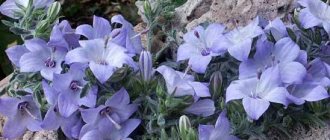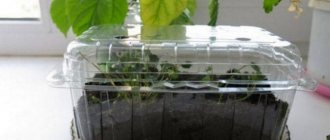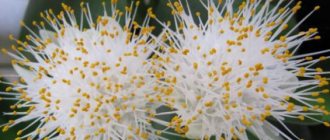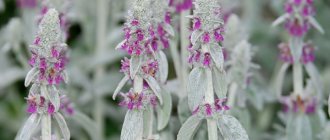Introduction
How did I first become acquainted with the beautiful flower “Bride and Groom”? My passion is growing indoor plants. They decorate the house with unusually bright flowers and variegated leaves. Watching how green pets develop is very interesting. In the spring, a friend gave me a small cutting of a plant and said that it was called “bride and groom”.
People gave a flower called campanula the romantic name “bride and groom”
I put it in water and a few weeks later, when roots appeared, I planted it in a pot. I used a soil mixture of greenhouse and leaf soil, peat and sand. The cutting took root easily and began to grow.
I placed the container with the plant in a deep tray and poured settled water into it every morning so that the plant did not lack moisture. Once every two weeks I watered it with special fertilizers for beautifully flowering indoor plants.
I pinched the quickly growing side shoots, and soon the bush became very branched and lush, numerous buds appeared on it, which bloomed one after another.
Composition of campanula and coleus
And somehow the plant became covered with the most delicate flowers. The bride and groom plant looked great on the window. In the summer I put it on the balcony, where she felt especially good.
After a long flowering at the end of summer, the campanula dropped its leaves, the shoots stretched out, I carefully cut them off and put the container in a cool place. With the onset of spring, I began to water the plants again and placed it on the windowsill. Soon new shoots appeared and already in mid-May the “bride and groom” pleased with their flowering again.
What to do if the Bride does not bloom
Sometimes it happens that the plant “refuses” to bloom. This situation can arise for several reasons:
- The bluebell grows in a larger pot than it needs. To produce many buds, you need a tight pot.
- The plant lacks certain substances to flower. During the period of increased growth, the Bride needs to be fed 2 times a month.
- Timely pruning is not carried out. Buds do not form on woody shoots, so the campanula needs to be rejuvenated annually.
- Sometimes the reason lies in improper placement of shoots. By nature, they should hang down, so any attempts to lift them up may be accompanied by a negative reaction from the plant.
The bride is an amazing flower that, with proper care, can give beauty and extraordinary tenderness. In return, it will not require special attention, so anyone can grow it.
Description
Hybrid with lilac flowers
Campanula is a well-known indoor plant that belongs to the bellflower family. It can be found in the wild in many countries of Southern Europe.
A significant number of species of this plant have been cultivated and are now actively used as indoor plants.
- Campanula can be either annual or perennial.
- Plants are varied in shape, flower color, size, and there are hybrid double forms.
- Campanula equifolia is cultivated as an indoor crop. This plant is perennial, with thin shoots, sometimes creeping, in rare cases hanging down up to 25 cm long.
- The arrangement of the leaves is alternate; the leaf blades are attached to the stems with the help of elongated petioles.
- The leaf shape is heart-shaped or oval with small teeth. The leaves range in color from light green to dark green.
- The flowers are collected in inflorescences of several pieces; after flowering, a small fruit appears in the form of a box.
- Among indoor flower lovers, the most common hybrid is “Alba” (with white flowers) and “Maya” (with blue or purple flowers). People call them “the bride and groom.”
Hybrid "Alba"
All representatives of the bellflower family are not very demanding; they need the most basic things - watering, moderate lighting, and periodic feeding.
Campanula flowering
Campanula is especially decorative during flowering. The flowers of the plant are shaped like bells, hence the name of the plant - “Campana” means “bell”.
The flowers of the plant are most often blue or white, collected at the ends of the shoots. With proper care, flowering is abundant and long-lasting - campanula blooms all summer.
A special feature of caring for campanula during flowering is the removal of faded dry inflorescences and leaves. Maintaining plant “hygiene” will increase the duration and intensity of flowering.
Lighting
This plant does not require lighting. It is not recommended to grow on southern and northern windows. When grown on windowsills facing south, it is recommended to protect plants from bright sunlight by creating shading.
It is desirable that the light be bright, but diffused
If you grow campanula on a north window, there is a risk of the shoots stretching. In such plants, the distance between the leaves increases, and the decorative appearance of the plant suffers from this.
Plants love a lot of light, but are afraid of direct, burning sunlight, especially on hot summer days. Provide them with partial shade.
How to buy Campanula bellflower seeds for the Bride and Groom on Aliexpress?
If you want to find seeds of various types of Campanula on the Internet, you will need to look through a large number of pages. This plant is not found very often in the virtual world, as we would like. It is also very difficult to find in ordinary flower shops in the city. But it is still possible.
Campanula plant
What do I need to do?
- Follow the special link to the Aliexpress website.
- Flip through the pages. Basically, such flowers can be found in the rare seeds section and in a single copy.
At the moment, the site does not offer seeds of such a plant. Browse the site periodically and maybe you will be lucky to buy flower seeds at a good price.
Temperature
Thermometer for monitoring room temperature
In spring and summer, the most optimal temperature is 23 – 26°C; in winter, it is better to keep plants at a lower temperature from plus 12 to plus 14°C.
In winter, do not leave the plant on the windowsill under which the heating radiator is located; it is better to move it to a cool place, but keep in mind that the lower limit is +12°C. Do not be afraid of temperature changes, as these plants tolerate them quite well.
Campanula has the ability to adapt to different temperatures, and thanks to this property, a flowering plant can be transferred from the room to the balcony, back and forth, without fear of any negative consequences.
Watering and humidity
Campanula loves water
As for watering, its scheme is classic: abundant in summer, moderate in winter.
1Spraying is recommended, especially in dry weather, and in summer during heat.
2Do not allow the soil to become excessively waterlogged. To avoid water stagnation, use drainage in the form of expanded clay balls.
3 In autumn and winter, limit watering to a minimum.
4In spring and summer, these plants need to be fed with complex fertilizers every 3 weeks.
5The best watering is from below.
Fertilizers
The use of complex fertilizers will allow you to obtain flowers with bright colors
Use mineral and organic fertilizers 2 - 3 times every thirty days (spring and summer). Water once every two weeks with special fertilizers for beautifully flowering indoor plants.
Transfer
At the end of summer, the growing season of the plant stops, and it requires preparation to enter a state of dormancy. The most acceptable method of propagation is vegetative : by cuttings, green shoots, by dividing the bush into several parts.
Plants need to be replanted more often. Most ornamental plants like to be replanted fairly frequently.
Repotting indoor plants
The fact is that when grown for a long time, no matter how beautiful the plant is, it loses its decorative effect over time, the shoots lengthen, and the distance between the leaves increases. It no longer looks so chic and fluffy, as if it is “balding”.
To avoid this, take cuttings and form new bushes from the resulting cuttings. After a long flowering at the end of summer, Campanella sheds its leaves, the shoots become elongated, and the decorative effect decreases.
External characteristics
There are many varieties of milkweed, but only one of the species is called a bride - fringed milkweed. This species boasts small but multiple buds located at the very top of the shoots. The buds also have a white tint, however, the bush was not nicknamed the bride because of them. The unusual name is associated with foliage with a white border (see photo). It is interesting that at the beginning of their growth the leaves are evenly green; they acquire a white edge later.
The shrub is small in height, reaching only 80-90 cm. However, it grows very lush. The leaves are 6-8 cm long, the stems branch well. The buds and foliage of the plant are not at all afraid of the sun, do not lose their decorative value, and do not fade even in severe drought. Euphorbia blooms from July until the first autumn frosts.
Application
In landscape design, spurge is highly valued. With the help of this light plant you can make remote corners of the garden more attractive and elegant. Due to the peculiar white color of the bush, it is possible to achieve a visual expansion of the space.
In group plantings, euphorbia is usually used to separate those plants whose colors do not combine well with each other. Euphorbia itself in this regard has a rare versatility, but its variegated foliage looks especially impressive against the backdrop of red and blue flowers: roses, delphiniums.
Reproduction
If the plant has grown enough and does not fit into the volume of the container, it must be divided into several parts. Carefully remove the bush from the pot with a lump of earth. Using a sharp knife, the rhizome is cut into pieces.
Don’t forget to treat the cut areas with crushed wood charcoal. Plant the resulting parts in new containers of smaller volume. It is not recommended to immerse plants deep into the soil. Immediately after transplanting, provide the plant with plenty of water and shade.
Using cuttings
Campanula cuttings
- Cuttings are very easy to obtain. When pruning elongated shoots, use the lower parts for rooting.
- Rooting occurs best in a mixture of peat and sand.
- For cuttings, it is necessary to provide greenhouse conditions; it is advisable to cover the plant with a polyethylene cap and regularly spray it with water from a spray bottle.
- The optimal rooting temperature is 20 – 24°C.
- After the shoots grow to 7 - 10 centimeters, pinch their tops. This procedure provokes the appearance of additional shoots. Your bushes will be more branched.
Cuttings can be resorted to in the summer. They will grow over the summer and autumn, but by the beginning of winter the green part needs to be cut off and the flower allowed to rest. Already in the first spring after transplantation, campanula can bloom with proper care and timely feeding.
Green shoots
This type of vegetative propagation should be resorted to in the spring, when young green branches grow at the campanula. They can be cut and rooted.
How to do it correctly:
1Separate the green shoot from the “heel”
2Plant it in a mixture of loose peat soil and sand
3Cover with plastic wrap
4Ensure greenhouse conditions
5Keep the container with young shoots in a cool place at a temperature of plus 12-15 degrees
6Don’t forget to spray and ventilate your miniature greenhouse every day
Mini greenhouse for rooting cuttings
Campanella takes root quite quickly; after two weeks, small roots form. After the plants begin to actively grow vegetative mass, move them to a brighter and warmer place.
When the plant reaches a height of ten centimeters, it is necessary to pinch it so that it begins to branch and bush.
Propagation by seeds
The seeds of this plant are very small; they need to be planted superficially in small bowls filled with soil mixture. It is advisable to cover the seeds with a thin layer of soil on top. For seeds during the germination period, it is necessary to provide a greenhouse effect, wrap the top with plastic film or glass.
Sprouted seeds
Be sure to provide periodic ventilation to prevent excess condensation from accumulating. After the third leaf appears, pick up the seedlings, do not forget to pinch, this will allow you to get a branchy bush. Plants grown from seeds usually bloom in the second year.
Musk mallow
It can also be called mallow. This is one of the elegant garden perennial plantings. It begins to bloom the next year after planting.
Characteristics and growing conditions
The bride is called musk mallow of the Alba variety. This plant is about 1 m high. It not only has beautiful, but also fragrant flower buds. Outwardly, they are a little similar to Chinese rose flowers; they reach 5 cm in diameter.
The area for planting mallow is chosen to be well-lit and protected from drafts. In the shade, this planting will not bloom so spectacularly. The soil should be enriched with nutrients and loose.
Attention! The landing site must be chosen immediately. Due to its branched root, mallow does not tolerate transplantation well.
The perennial garden bride flower is easy to care for and does not have any special requirements for maintenance. The measures that need to be taken for good growth of the bush are as follows:
- moderate watering as needed;
- spring application of organic matter will contribute to the abundant formation of green mass and buds;
- after watering, the soil is loosened;
- overgrown shoots are tied to a support;
- after the buds have bloomed, they are removed so that the mallow does not waste energy on forming seeds;
- in the fall, after the end of the growing season, the above-ground part is cut off.
- In winter, the root area is mulched, covered with spruce branches, sawdust, and leaves.
The garden flower perennial bride is rarely susceptible to diseases, but if there is an excess of moisture, there is a danger of infection by various fungi. To eliminate them, the planting is sprayed with a fungicide. Aphids or spider mites can also cause damage. To get rid of them, mallow is treated with an insecticide.
Don't forget about moderate watering
Reproduction
The most popular method of propagation is by sowing seeds in spring, in loose, nutritious soil. Small furrows are made, watered, and seeds spill into them. From above they are covered with a thin layer of soil. After 3 weeks, the first shoots will appear. Musk mallow will begin to bloom in a year.
If a gardener gets one bush of this plant, you can try to propagate it with cuttings. Here's how it's done:
- the stalk is cut off with a sharp tool;
- dipped in crushed coal;
- left for some time to dry;
- planted in a small pot, at the bottom of which drainage is placed and watered;
- The top of the plant is covered with plastic film.
Important! The cutting tool must be well disinfected.
The perennial bride flower can be planted in the garden alone or in combination with other green spaces. It will give the garden solemnity and elegance. With proper care, it will grow in one place for a long time and delight others with spectacular flowering.
- Author: Maria Sukhorukikh
Rate this article:
- 5
- 4
- 3
- 2
- 1
(0 votes, average: 0 out of 5)
Share with your friends!
Diseases and harmful insects
At home, plants are much less susceptible to diseases and pests. However, they are not 100% protected. If not properly cared for, a number of problems can arise.
Gray rot
With constant waterlogging of the soil, when there is no drainage in the flower pot, the water stagnates, which in turn leads to acidification of the soil.
Gray rot thrives in damp soil. When affected by gray rot, plants wither and the root system begins to rot.
An unpleasant odor appears in the room where the flower affected by gray rot is located. Sometimes, when the rotting goes very far, the flower can no longer be saved.
In any case, first of all, you need to cut off the rotten twigs and leaves and throw away the old soil. Transplant the flower into new light soil, reduce watering.
Fusarium
If temperature conditions are not observed, as well as in the absence of light, the viability of the plant decreases. Sometimes fusarium can be observed on the “bride and groom” flower; it is accompanied by yellowing of the tips of the leaf blades.
In severe forms, the leaves die and the shoots wither from the root.
Heart rot
If you find brown heart-shaped spots with a gray coating on the leaves, then it is likely that the plant has developed brown heart-shaped rot. This disease is caused by pathogenic microscopic fungi.
To combat them, fungicides are used, while watering is reduced and the plants are regularly ventilated.
Spider mites, aphids, scale insects
If the plant is in a dry room, aphids or scale insects may appear. At the first symptoms of these diseases, treat the plants with insecticide preparations. A proven folk remedy against aphids and scale insects is a soap solution.
Spider mites are the scourge of many indoor plants. Use broad-spectrum insecticides to combat it.
An effective drug against aphids
Most often, the companula is affected by aphids
Most often, companula is affected by aphids. Aphids multiply very quickly, so control should begin when they first appear. It is better to use systemic preparations that not only destroy the pest during treatment, but also continue to act for some time in the plants themselves.
There is a drug "Biotlin" designed to protect against sucking pests.
The treatment solution is prepared at the rate of 0.5 ml of the drug per 1 liter of water. Penetrating into the plant within a few hours, the drug will protect it for at least two weeks.
Euphorbia fringed
Another name - Euphorbia marginata - is a real decoration of the garden. Euphorbia looks very solemn and elegant due to its soft green leaves with a white border. Due to these qualities, and also because the bush grows very quickly, it is popularly called the “rich bride.”
Characteristics and conditions of detention
The bride is a perennial flower, but in fact in most regions of Russia this plant is cultivated as an annual. In winter, the entire above-ground part freezes. But already in the spring a whole scattering of young seedlings appears from seeds spilled by milkweed on the ground.
Perennial garden flower Bride
The height of the bush under favorable conditions reaches 90 cm. At the very top of the shoots there are small flowers. But they are not the main decoration of this planting, but the leaves with a white border, due to which it seems that the bush is all in bloom.
The landing site should be well lit by the sun. The brightness and power of the bush depends on this. Euphorbia prefers soil that is light, loose, air- and water-permeable.
Watering milkweed is done regularly, but in moderation. Excess moisture can lead to rotting of the roots and death of the bush. After each watering, the soil is loosened. Euphorbia grows well, so it can bend under the weight of its mass. To avoid this, the plant is tied up.
Flowerbed with the bride
In the spring, when the seedlings have already grown, the soil is fed with organic matter. Then, several times a season - with complex fertilizers. The bride, as a rule, is not affected by diseases and pests.
Reproduction
There are 2 ways to grow garden flowers on your property: cuttings and seeds. It is possible to grow by cuttings, but it is not advisable, since a lot of seeds are collected from the plant and they germinate well.
Seeds should be sown in the fall, after the possibility of germination has disappeared. The best time is before snowfall. When the snow melts, it will pull the seeds into the ground, where they will germinate in the spring.
In addition to growing in the garden plot, the perennial flower bride is planted in beautiful flower pots to be kept on terraces, porches, well-lit balconies and loggias. It can also be used to make wedding bouquets.
Attention! Euphorbia juice is poisonous, so you need to wear gloves when working with it: sensitive people may experience allergies.
Varieties
Terry hybrids
Terry hybrids
Terry hybrids Recently, the most beautiful hybrids of terry campanula have appeared. The terry hybrid was bred by crossing the Carpathian bellflower and Campanula sparrowfolia.
Terry companula looks like a small bush dotted with large double flowers. The stems are shortened, the leaves are densely arranged.
It should be remembered that double forms of flowers, as a rule, are more finicky and do not take root with all amateur gardeners.
Carpathian campanula
Carpathian Campanula in natural conditions
Carpathian Campanula This plant can grow both in open ground and indoors. This is a herbaceous plant that resembles a bush.
Its height can reach 30 cm. The leaves are located below in the form of a basal rosette; they are oval in shape.
The flowers are quite large, up to 6 cm in diameter, and come in white, blue, lilac and violet colors. Under natural conditions, this plant is found in the Carpathian mountains.
It blooms from May to August.
Kalina Buldenezh
Viburnum variety Buldenezh (Snow Globe) is a perennial shrub with white, large (7-15 cm) flower caps. She is also sometimes called the bride.
Description and growing conditions
This is a tall (up to 3.5 m) shrub that begins to bloom in late spring - early summer. Not only its buds are decorative, but also its carved leaves. The crown reaches a diameter of 2-4 m. The older the viburnum is, the more abundantly it blooms.
The landing site should be slightly shaded. This could be the wall of a house, a fence, or a tree growing next to the viburnum. The soil should be light and loose; sand is added to the heavy one. Dolomite flour or lime is added to the acidified soil.
Planting in a dark area
Landing
Viburnum Buldenezh is planted in open ground in spring or autumn. Let's look at this process step by step.
- A planting hole is dug with a diameter 2 times larger than the root system.
- Compost is poured into the bottom of the pit, then the prepared substrate.
- A depression is made in the middle into which the seedling is inserted.
- The roots are straightening out.
- The remaining soil is filled in, which is then compacted and watered.
The tree trunk circle is mulched to protect the root system from drying out and retain moisture in the soil.
Viburnum Buldenezh loves abundant watering, especially the amount of moisture you need to monitor while the bush is young. In the year of planting, the bride is not fed: the fertilizer that was poured into the planting hole is enough for her. Organic matter is added next spring, and complex fertilizer is applied in the fall.
Important! Before applying fertilizer, in order not to burn the roots, the soil must be shed with water. You should water again after application so that the nutrients reach the root system faster.
After flowering, formative pruning is performed. All branches with buds are pruned so that young shoots grow, on which white balls form next year.
Like many green spaces, viburnum Buldenezh sometimes gets sick and is also attacked by pests. It is better to prevent these misfortunes by spraying the bush with approved chemicals in the spring.
Reproduction
Starting in spring, viburnum Buldenezh is propagated by layering. To do this, the lower branches are bent to the ground, fixed with something, and compost is poured on top.
The rooting site is well watered. The shoot is usually ready for independent life by next spring. Together with the root, it is separated from the mother plant and planted in a permanent place.
Another method of propagating the bride is cuttings. For these purposes, in June, shoots with 2 pairs of buds are cut and rooted in moist soil, covering them with a transparent cap. The greenhouse is constantly ventilated, the cuttings are regularly watered. When roots form on them, they are transplanted into a school for growing, and after a year they are planted in a permanent place.











